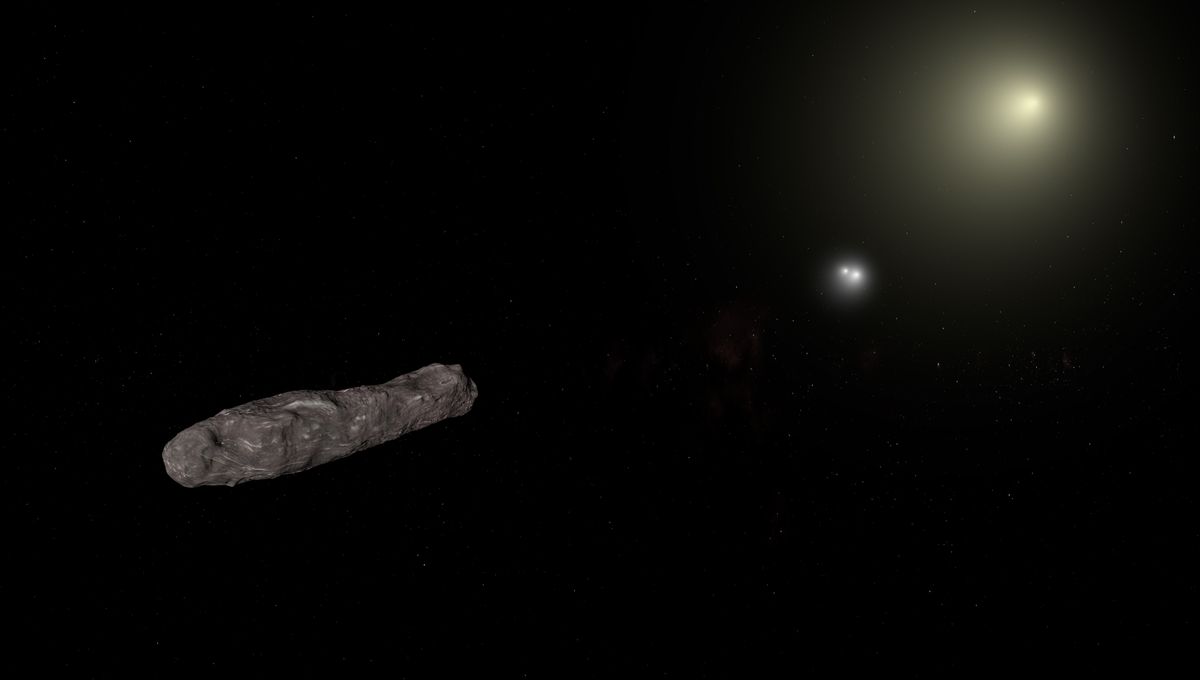
Astronomers have calculated the risk posed by interstellar visitors such as ‘Oumuamua and 3I/ATLAS hitting the Earth. They conclude that, unlikely as such an event is within anyone’s lifetime, it’s possible to calculate the most vulnerable places and times. Before revealing their conclusions (still to pass peer review), we’d like to stress that the difference is so small, we definitely don’t recommend changing your holiday plans based on avoiding incoming space rocks.
The recent discoveries of interstellar comets 1I/’Oumuamua, 2I/Borisov, and 3I/ATLAS have caused some people to ponder whether these objects pose a threat to Earth. It doesn’t take long to realize that danger is astonishingly small. After all, it’s been millions of years since the planet has been hit by a major celestial impactor; even localized damage doesn’t happen often. That’s despite the fact that we have recorded thousands of home-grown comets and asteroids getting closer than any of these three.
It’s true the greater relative speed of an interstellar object would mean a small one could do as much damage as something larger but local, but that doesn’t make up for the relative frequency of the two categories. Most people would be satisfied with that, and a few divert into baseless fantasies about these objects as alien visitors, but Dr Darryl Seligman of Michigan State University, Dr Dušan Marčeta of the University of Belgrade, and Dr Eloy Peña-Asensio of Politecnico di Milano decided to dig deeper. They took what we know about our place in the galaxy and worked out the sort of path interstellar visitors are most likely to arrive on, translating this to the threat zone on Earth.
The trio estimate between 1 and 10 interstellar objects around 100 meters (328 feet) across should have hit Earth during its history, based on very rough estimates on the numbers expelled from other star systems. Unlike strikes from home-grown asteroids or comets, these are likely to be relatively evenly distributed through the Earth’s history, but prospects for identifying any craters are low. Most would have been erased by tectonic activity or atmospheric effects, and, the authors note that “distinguishing interstellar impact craters from Solar System impact craters morphologically would be challenging.”
Craters from interstellar impactors are more likely to have survived on the Moon. Finding them among all the others could be a true needle-in-a-haystack challenge, although one previous study argued they would have distinguishing features as a result of the exceptional impact speed.
You might expect that interstellar threats could come from any direction; strictly speaking that is true. However, it is much more likely that an interloper will come from near the plane of the galaxy – recognizable by tracing the path of the Milky Way across the sky – rather than high galactic latitudes. After all, this is where most of the stars interstellar objects once orbited are located.
Although by definition an interstellar object is not bound by the Sun’s gravity, it will be influenced by it. That gravity focuses orbits, particularly of the objects moving more slowly when they first approach. Using these and other suspected patterns to incoming objects, Seligman, Marčeta, and Peña-Asensio modeled the behavior of 260 billion “synthetic objects” following probability distributions.
Any interstellar object must be moving fast relative to the Sun, or else it would be captured by its gravity. The three we have observed peaked at 87.71 kilometers/second (196,202 miles per hour), 43.9 km/s (98,202 mph) and 68.3 km/s (152,783 mph), respectively. The authors expect the peak of the distribution to be 45 km/s (100,000 mph) in terms of heliocentric speeds. Factoring in the Earth’s movement around the Sun, the most likely speed for an object to be travelling relative to us when it hits is 72 km/s (162,000 mph), the authors say. By contrast, asteroids in solar orbits hit at 11 km/s to 73 km/s (24,606 to 163,296 mph).
The effect of solar gravitational focusing on objects coming from near the galactic plane means that impactors are more likely to land near the Earth’s equator. Their frequency also should peak in the Northern Hemisphere’s winter – just when many residents of northern latitudes are seeking tropical warmth – but the fastest moving objects (making the biggest bang) are concentrated in spring. Surprisingly, since the Milky Way is most prominent in the southern sky, there is a slightly higher anticipated rate of impact in the Northern Hemisphere.
It’s worth remembering, however, that not only is the prospect of such an object hitting Earth in any season tiny, the difference between the peak month and the safest is also relatively minor.
The calculations were done for interstellar objects that escaped red dwarf star systems, on the basis these are the most common type. However, the authors note that at least some of their conclusions would apply even more strongly for visitors that originated around more massive stars.
The study is undergoing peer review, and a preprint is available via arXiv.
[H/T: Universe Today]
Source Link: When And Where Interstellar Objects Like 3I/ATLAS Are Most Likely To Hit Earth